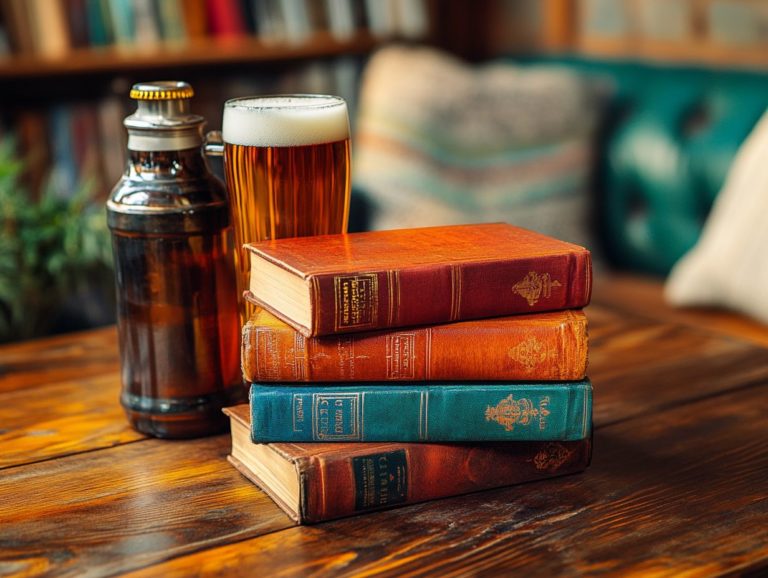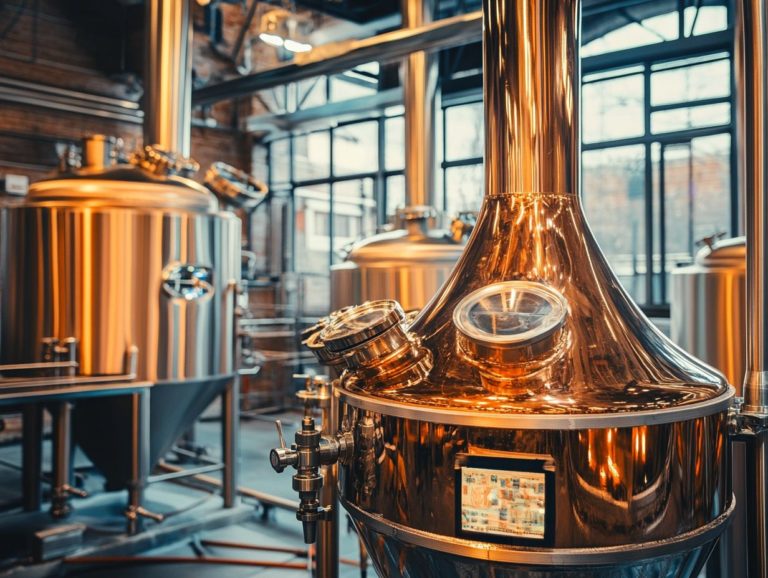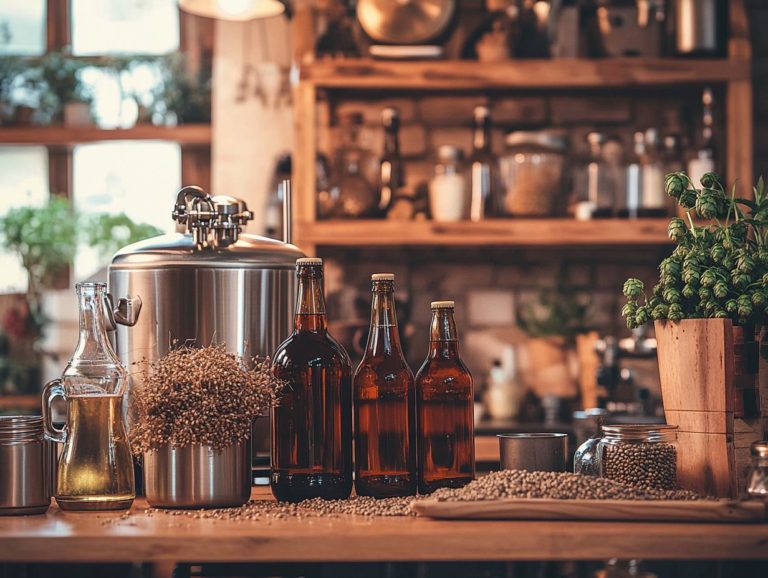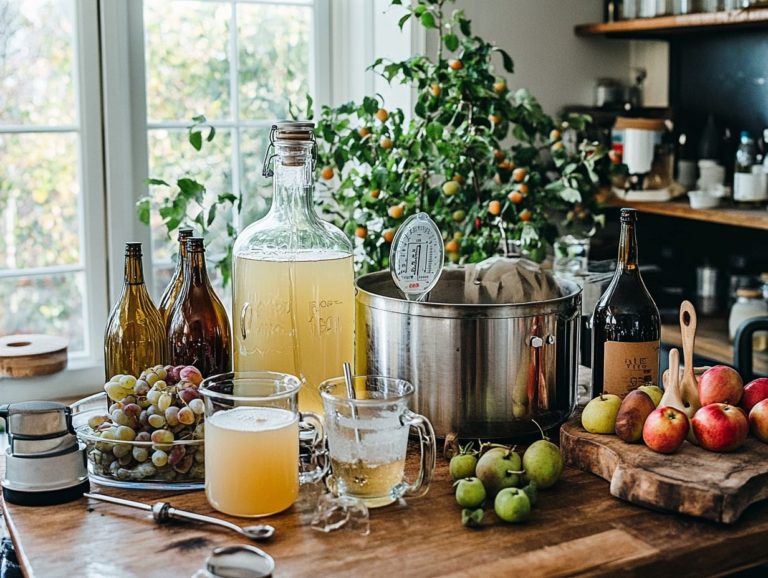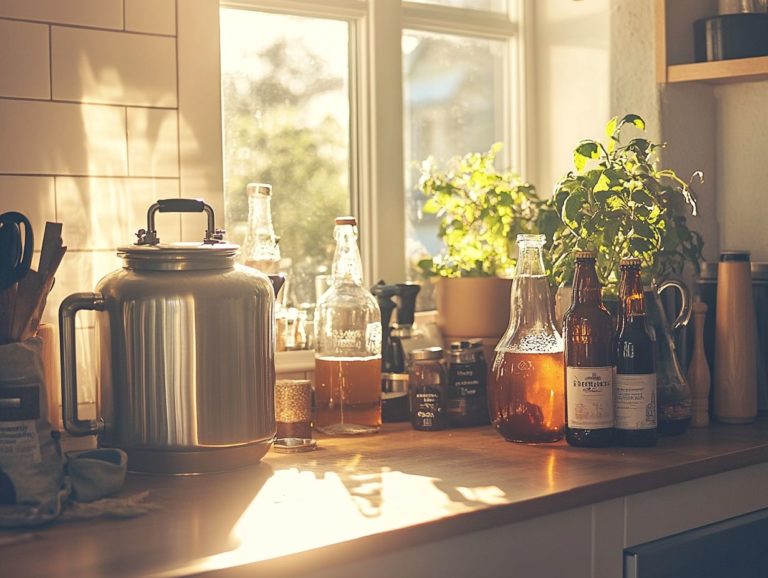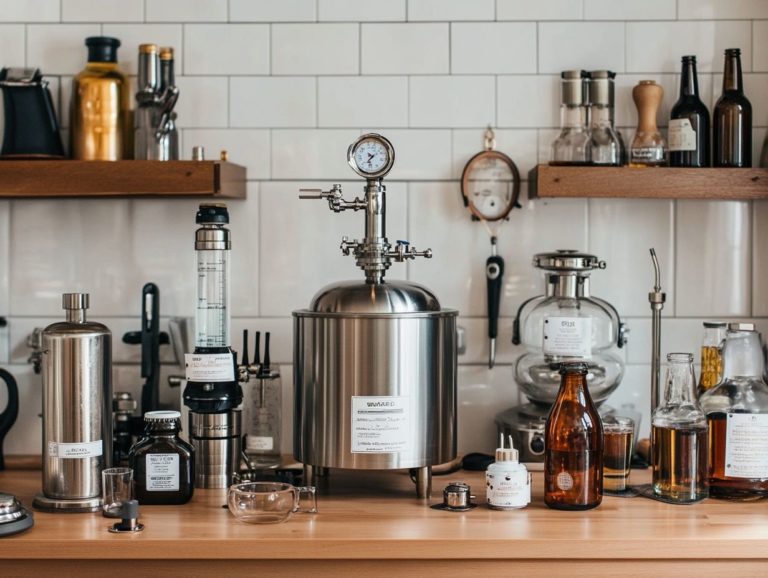The Most Essential Brewing Instruments for Beginners
For coffee enthusiasts and home brewing aficionados, the right tools can transform your experience of crafting the perfect cup. This article explores essential brewing instruments for beginners, including high-quality grinders, precise scales, and brewing methods like pour-over and French press. We will also cover the essential equipment needed to complete your brewing setup.
We highlight common pitfalls and provide valuable tips to refine your skills, ensuring you can create delightful coffee recipes at home. Get ready to take your brewing skills to the next level!
Contents
- Key Takeaways:
- 1. A Good Quality Coffee Grinder
- 2. A Digital Scale and Hydrometer
- 3. A Pour-Over Coffee Maker and Brewing Kettle
- 4. A French Press
- 5. A Gooseneck Kettle
- 6. A Coffee Dripper
- 7. A Coffee Thermometer
- 8. A Coffee Roaster and Fermentation Chamber
- 9. A Coffee Siphon and Home Brewing Essentials
- 10. A Coffee Scale
- What Is the Best Way to Brew Coffee for Beginners?
- What Are the Different Types of Coffee Brewing Methods?
- What Factors Should Be Considered When Choosing Brewing Instruments?
- How Can One Improve Their Brewing Skills?
- What Are the Common Mistakes Made by Beginners in Coffee Brewing?
- How Can One Create Their Own Unique Coffee Recipes?
- Frequently Asked Questions
- What are the most essential brewing instruments for beginners?
- Why do I need a thermometer for brewing?
- What is the purpose of a hydrometer in brewing?
- Do I need measuring cups or spoons for brewing?
- Can I use any funnel for brewing?
- What should I look for in a brew kettle for beginners?
Key Takeaways:
- Invest in a good quality coffee grinder for fresher and more flavorful coffee.
- Use a digital scale to ensure precise measurements for a balanced brew.
- A pour-over coffee maker is an easy and versatile option to experiment with.
- Consider beginner kits for both coffee and home brewing.
1. A Good Quality Coffee Grinder
A high-quality coffee grinder is essential for anyone serious about brewing. It ensures your coffee beans are ground to the ideal size for the best flavor.
You ll encounter two main types of grinders: burr grinders and blade grinders. Burr grinders provide a consistent grind size, which helps achieve the desired flavor profile. In contrast, blade grinders can result in uneven grinds, affecting overall quality.
For methods like espresso, a burr grinder is the preferred choice due to its ability to deliver the precise grind size necessary for great flavor. Look for a grinder with adjustable settings to tailor the grind to your preferences.
2. A Digital Scale and Hydrometer
A digital scale is crucial for achieving precision in coffee brewing. It allows you to measure your ingredients accurately, maintaining the ideal coffee-to-water ratios.
Investing in a digital scale enables you to explore various brewing techniques. For example, a basic pour-over ratio of 1:15 means you should use 15 grams of water for every gram of coffee. For French press, a 1:12 ratio can enhance richness.
These precise measurements standardize your results and encourage experimentation with different coffee types. This meticulous approach enhances the taste and experience of your favorite coffee creations.
3. A Pour-Over Coffee Maker and Brewing Kettle
A pour-over coffee maker offers you the opportunity to take command of various parameters in the brewing process. This results in enhanced flavor extraction and a superior cup of coffee that outshines traditional methods.
This approach allows both baristas and home brewers to meticulously manage water temperature and pouring techniques. These factors are essential for unlocking the full spectrum of flavors from the coffee grounds.
For instance, utilizing a gooseneck kettle gives you the precision to pour steadily and control the flow over the coffee bed with finesse. In home brewing, a brewing kettle is equally vital for precise control.
You ll find an array of pour-over makers to choose from, including:
- the classic Chemex
- the Melitta cone
- the Hario V60
Each of these options brings its own distinct characteristics that can influence brewing time and flavor profile. To achieve the best results, start with freshly ground coffee beans and maintain a consistent water temperature ideally between 195 F to 205 F.
Adopt a circular pouring motion to ensure the grounds are evenly saturated. Home brewers should also ensure sanitation practices are followed, such as using a food-grade sanitizer to prevent contamination.
4. A French Press
The French press stands out as a favored immersion brewing device. It enables you to extract rich flavors and essential oils from coffee grounds.
This method enhances the extraction process by steeping coarsely ground coffee in hot water, delivering a satisfying and complex taste profile. Aim for a brewing time of around four minutes to strike the perfect balance between bitterness and flavor richness.
Remember, the grind size is crucial; a coarse grind prevents over-extraction, ensuring a smoother sip. If you’re feeling adventurous, why not try cold brew? Steep your grounds in cold water for 12 to 24 hours for a delightfully refreshing take on your coffee!
Home brewers often opt for cold fermentation techniques to craft unique beer recipes. This method can yield distinct flavors and aromas in the final product.
5. A Gooseneck Kettle
A gooseneck kettle is an essential tool in your coffee brewing arsenal. It offers you precise control over both water temperature and pouring.
This level of control is crucial for achieving the perfect extraction and flavor profile across various brewing methods, such as pour-over and French press. The elegantly designed gooseneck spout facilitates a slow and steady stream of water.
This attention to pouring technique helps you avoid the pitfalls of under-extraction or over-extraction. It’s a simple act that influences the strength of your brew and elevates the aromatic qualities of your coffee.
Maintaining the right water temperature is essential. Different types of coffee beans demand specific heat levels for optimal brewing.
Fortunately, the market offers a range of gooseneck kettle models, from traditional stovetop options to sophisticated electric kettles with temperature control settings.
This variety ensures that you can select the kettle that aligns perfectly with your brewing preferences. Now, it’s your turn to explore these brewing methods and discover your favorites!
6. A Coffee Dripper
Why You Need a Coffee Dripper
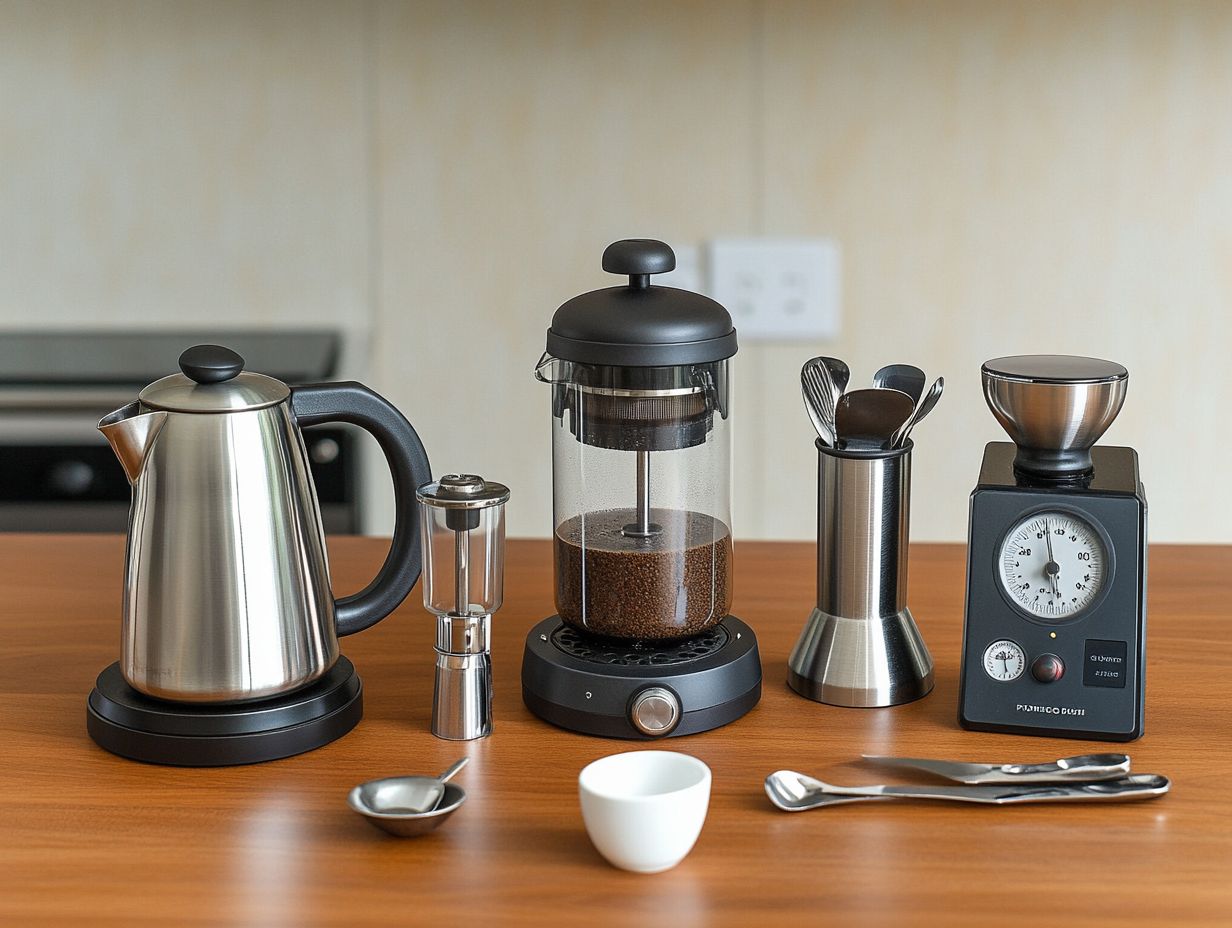
A coffee dripper is your ticket to single-serve brewing. It s perfect for those who truly appreciate the artistry of coffee extraction.
With this tool, you can enjoy a fresh cup every time without the hassle of elaborate brewing setups. For beer lovers, you can achieve a similar experience with small-batch brewing kits.
These elegantly simple devices allow hot water to flow through freshly ground coffee. This carefully pulls out its rich flavors during the brewing process.
Whether you choose a classic pour-over cone or a stylish Chemex, each coffee dripper provides a unique brewing experience. Each type highlights distinct flavor profiles.
For the best results, use freshly ground coffee and ensure the water is at the right temperature. Maintain a steady pouring technique to unlock the full potential of your coffee beans.
7. A Coffee Thermometer
The Importance of Coffee Temperature
A coffee thermometer may seem simple, but it s an essential tool for achieving brewing precision. It monitors water temperature to ensure the best flavors are extracted from your coffee grounds.
Recognizing how important water temperature is can elevate your coffee-making into an extraordinary ritual. The ideal brewing range is typically between 195 F to 205 F (90 C to 96 C).
If your water is too hot, you’ll risk over-extraction and end up with a bitter brew. If it’s too cool, you might find yourself sipping on a weak flavor.
Use your coffee thermometer effectively by immersing it in the brewing water. Make sure it s calibrated and reading accurately to refine your craft.
8. A Coffee Roaster and Fermentation Chamber
Exploring Roasting and Fermentation
A coffee roaster gives you control over the roasting process. You can create unique flavor profiles by adjusting roast levels to highlight the characteristics of various coffee beans.
A fermentation chamber helps you control fermentation temperature for optimal yeast activity. This hands-on approach deepens your appreciation for coffee’s flavor spectrum.
More and more coffee lovers are trying home roasting! You can use everything from simple stovetop popcorn makers to dedicated home roasters.
By adjusting variables like time and temperature, you can discover your ideal roast. Whether you prefer a brighter, lighter profile or a rich, caramelized darkness, the possibilities are endless!
9. A Coffee Siphon and Home Brewing Essentials
A coffee siphon, often referred to as a vacuum brewer, is a brewing method that impresses the eye and elevates your coffee experience. The heat creates steam that pushes water into the upper chamber, where it mixes with coffee grounds. When you remove the heat source, the pressure drops, and the brewed coffee is drawn back down, leaving the grounds behind.
This intricate dance between steam and vacuum enhances the flavors for a vibrant and aromatic brew. It also offers an engaging visual spectacle that will surely captivate any coffee enthusiast. If you’re into home brewing, watching a siphon brew coffee can be as captivating as observing the fermentation process of beer in a fermentation bucket.
To achieve the best results, use freshly ground coffee and maintain an ideal water temperature, which typically falls between 195 F and 205 F. This attention to detail will allow you to extract optimal flavors from your beans, ensuring a remarkable cup every time.
10. A Coffee Scale
A coffee scale is an essential tool for accurately measuring both coffee grounds and water. This ensures you achieve consistent results and optimize your brewing process, whether you’re using a French press, pour-over, or espresso machine.
By obtaining precise measurements, you can replicate your favorite brews with each cup. The importance of consistency cannot be overstated; even slight variations in the coffee-to-water ratio can lead to vastly different flavors, much like varying hydrometer readings in beer brewing.
To make the most of your coffee scale, begin by zeroing it out with your container for added precision. For methods like pour-over, aim for a standard ratio of 1:15 coffee to water, while an espresso machine typically requires a 1:2 ratio. Familiarizing yourself with these ratios enables you to brew intentionally, culminating in a perfect cup every single time.
What Is the Best Way to Brew Coffee for Beginners?
As you embark on your journey into the world of coffee brewing, start with simple methods like the French press or pour-over. These techniques allow for easy experimentation and help you grasp essential brewing fundamentals, all while ensuring a delicious cup every time.
Both methods yield rich, flavorful coffee and introduce you to vital skills such as precise measuring, timing, and water temperature control. With just a basic grinder and kettle, you can significantly enhance your coffee experience without feeling overwhelmed. For instance, using a coarser grind in the French press helps prevent over-extraction. Executing a steady, controlled pour in the pour-over method guarantees even extraction.
Choosing quality equipment can be an exciting adventure! By starting with a reliable coffee maker and a comfortable scale, you lay the groundwork for a fulfilling brewing journey. This approach allows you to build your confidence and refine your palate with each cup you create. Similarly, beginner kits in home brewing beer often include all the essential equipment you need to start your DIY brewing adventures.
Don t wait start your coffee adventure today!
What Are the Different Types of Coffee Brewing Methods?
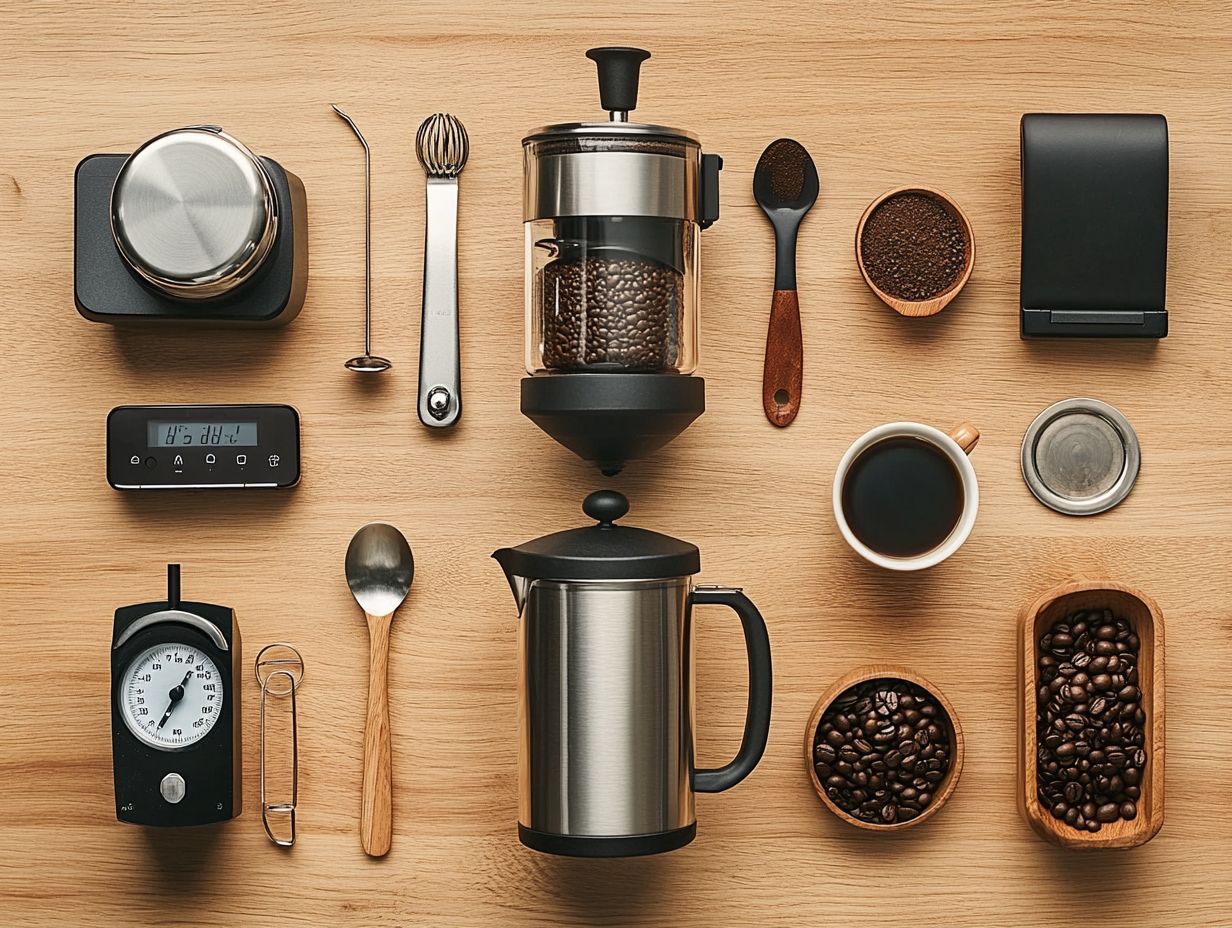
You ll find a fascinating array of coffee brewing methods, each offering its own distinct approach and flavor profile. From traditional techniques like the French press and drip brewing to modern approaches such as cold brew and AeroPress, the options are as diverse as coffee itself.
As you explore these methods, you ll uncover a rich tapestry of possibilities that cater to your coffee-loving heart. Take the French press, for example; it delivers a robust, full-bodied brew that showcases the natural oils of coarsely ground beans. This makes it the perfect pick for those who relish a heavy mouthfeel.
On the flip side, drip brewing presents a cleaner and more delicate taste profile, ideal for highlighting the nuances of lighter roasts. If you re in the mood for something smoother and mellower, cold brew is your go-to, offering a less acidic experience that pairs beautifully with medium to darker coffee varieties.
Then there s the AeroPress, which marries the best of both worlds. With its ability to control steep time and water temperature, it allows you to craft a complex flavor that can be tailored to your specific preferences. While each method requires its own equipment, your choice will shape your coffee experience, so choose wisely!
What Factors Should Be Considered When Choosing Brewing Instruments?
When choosing your brewing instruments, it s crucial to consider several factors that can significantly impact your coffee experience. Think about the type of coffee you desire, your personal flavor preferences, the strength you enjoy, your budget, and how complex you want the brewing process to be.
Taking the time to evaluate these elements will pay off. The right equipment can truly elevate your coffee journey. If you’re just starting out, you might want to opt for something user-friendly, like a French press or a pour-over system. Both are budget-friendly and deliver a delightful flavor profile.
For those ready to make a bit more of an investment, an espresso machine could be your gateway to crafting a wide array of concentrated coffee drinks. Be prepared for a more challenging learning process. On the beer side, investing in a quality brewing kettle or a plastic bucket for fermentation can be similarly beneficial, especially when you consider the 5 essential tools for home brewing success.
In terms of brewing style, consider whether you want to automate your process with a drip coffee maker or if you d prefer the hands-on approach of something like an AeroPress, which offers unique and varied flavor extractions.
Ultimately, understanding your individual preferences everything from strength to brewing time will guide you in selecting the best brewing equipment tailored to your taste.
How Can One Improve Their Brewing Skills?
Improving your brewing skills is an art that thrives on practice, experimentation, and the valuable lessons learned from both your triumphs and missteps. As a coffee enthusiast, your goal is to refine your techniques and grasp how various elements influence the final flavor of your brew.
One highly effective way to expedite this learning journey is by keeping a brewing journal. In this journal, you can meticulously document every detail of your brewing sessions from bean types and grind sizes to water temperatures and steeping times. This record will not only help you spot trends and preferences but also serve as a compass for future adjustments.
By diversifying the types of beans you use and experimenting with different brewing methods be it pour-over, French press, or espresso you can cultivate a richer appreciation for flavor profiles. Seek constructive feedback from seasoned brewers in online communities and forums. This can provide you with fresh perspectives and invaluable insights that will undoubtedly enhance your brewing adventure.
What Are the Common Mistakes Made by Beginners in Coffee Brewing?
As a newcomer in the art of coffee brewing, you may find yourself falling into common traps that can diminish the quality of your brew. These include incorrect grind sizes, improper water temperature, and inadequate attention to brewing time.
Each of these factors can lead to a less than stellar coffee experience. For example, if you use a grind that’s too coarse or too fine, you can drastically alter the flavor profile, resulting in coffee that might taste either weak or overly bitter.
Water temperature is also important. Using water that s either too hot or too cold can lead to under-extraction or over-extraction, ultimately affecting both the aroma and the taste of your brew.
It s also crucial to pay attention to brewing times; each method has its own specific duration to fully extract those rich flavors while avoiding any undesirable notes. Recognize these pitfalls and implement simple solutions. Invest in a quality grinder, use a thermometer, and adhere to brewing guidelines to significantly elevate your coffee-making journey.
The importance of cleaning and sanitizing your equipment cannot be overstated, a practice shared with beer brewing tips.
Remember, every mistake is a valuable lesson on your path to brewing perfection!
How Can One Create Their Own Unique Coffee Recipes?
Creating unique coffee recipes presents you with an exciting journey of experimentation, where you can blend different brewing methods, flavor combinations, and ingredients to unearth new and delightful ways to savor your favorite beverage.
Imagine trying single-origin beans from Ethiopia, bursting with fruity notes, and then daring to blend them with the rich, robust flavors of Brazilian coffee the possibilities are truly endless. You might begin by fine-tuning the coffee-to-water ratio to discover the strength that appeals to your palate.
Perhaps you ll add a pinch of cinnamon for that cozy warmth or a splash of vanilla to introduce a hint of sweetness. Likewise, in home brewing beer, you can experiment with brewing ingredients like hops, malt, and yeast to create your own beer recipes.
Venturing into variations like cold brew versus pour-over can open up entirely new flavor profiles, offering a choice between a smoother or brighter cup. Crafting your signature recipe involves fine-tuning these elements until they align perfectly with your taste, transforming each cup into a personalized experience that reflects your creativity and individuality.
Whether you are into home brewing or exploring different brewing techniques, the possibilities are endless.
Frequently Asked Questions
What are the most essential brewing instruments for beginners?
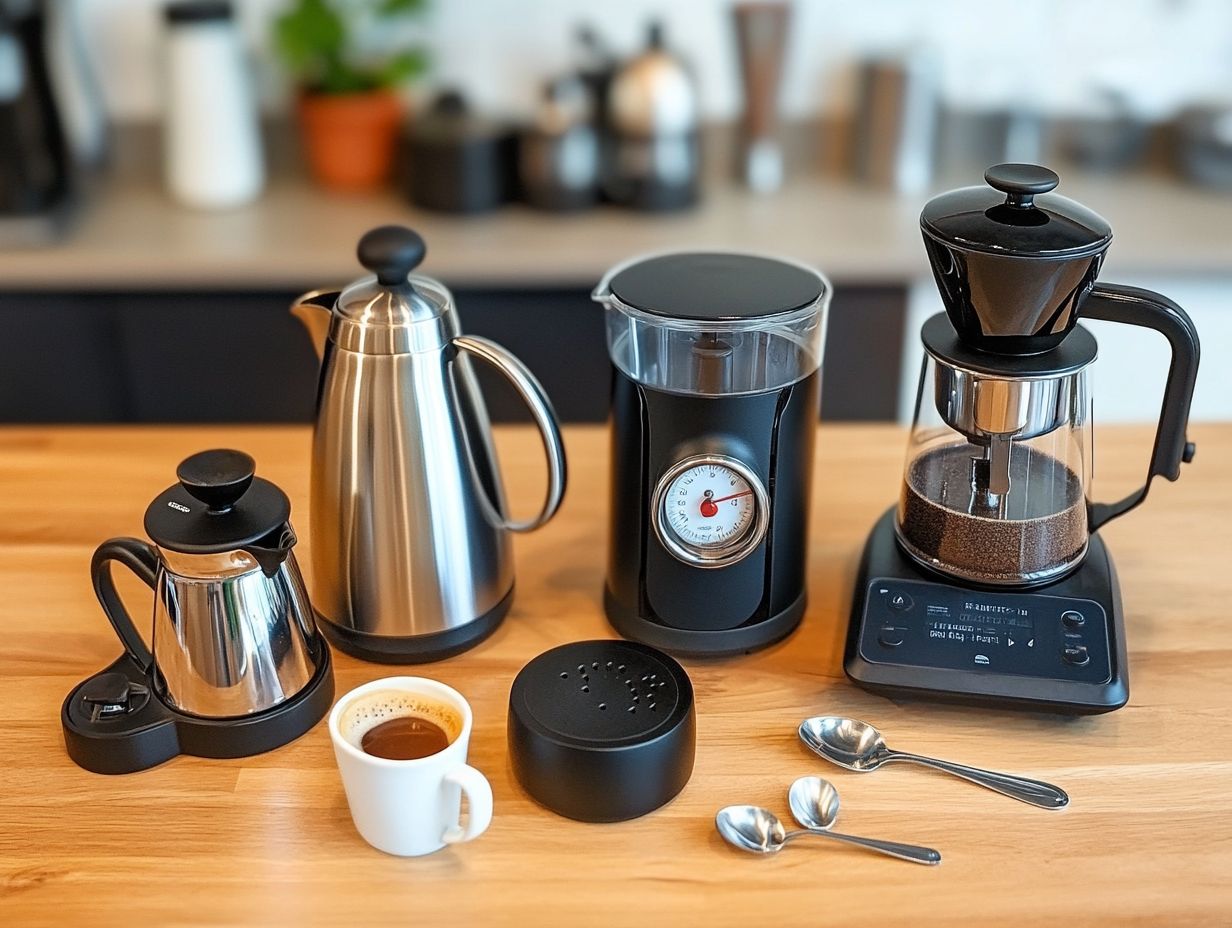
The most essential brewing instruments for beginners include a thermometer, hydrometer, fermentation bucket, measuring cups or spoons, a funnel, a stirring spoon, and a brew kettle. Many beginner kits come with these tools to get you started on your home brewing journey.
Why do I need a thermometer for brewing?
A thermometer is necessary for brewing to ensure that the temperature of the liquid is at the correct level for the brewing process. This is crucial for achieving the desired flavors and aromas in your brew, especially when dealing with fermentation temperature.
What is the purpose of a hydrometer in brewing?
A hydrometer measures the specific gravity of the liquid, indicating the sugar content. This is important for determining the alcohol level and the fermentation process of your brew. Using a hydrometer jar can make this task easier and more accurate.
Do I need measuring cups or spoons for brewing?
Yes, measuring cups or spoons are necessary for accurately measuring the ingredients in your brew. This helps you keep your recipes consistent and achieve the desired flavors in your final product. Consistency is key in both extract brewing and all grain brewing.
Can I use any funnel for brewing?
Using a brewing-specific funnel is a smart choice to keep your flavors intact! However, any clean and sanitized funnel can also be used. Good sanitation practices are crucial throughout the brewing process.
What should I look for in a brew kettle for beginners?
For beginners, a brew kettle with a capacity of at least 5 gallons is recommended. It should have a tight-fitting lid, a thermometer, and a spigot for easy transfer of the liquid. Investing in a stainless kettle is also a good idea due to its durability and ease of cleaning.

